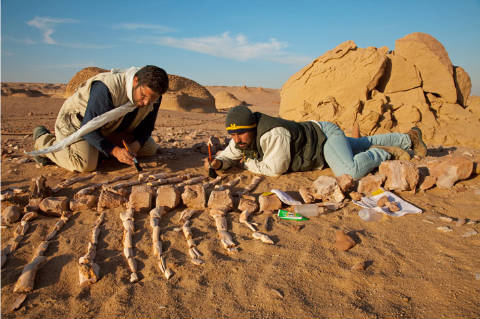Subtle variations in sperm-whale calls suggest that individuals announce themselves with discrete personal identifier. To put it another way, they might have names.
The findings are preliminary, based on observations of just three whales, so talk of names is still speculation. But “it’s very suggestive,†said biologist Luke Rendell of Scotland’s University of St. Andrews. “They seem to make that coda in a way that’s individually distinctive.â€
Rendell and his collaborators, including biologists Hal Whitehead, Shane Gero and Tyler Schulz, have for years studied the click sequences, or codas, used by sperm whales to communicate across miles of deep ocean. In a study published last June in Marine Mammal Sciences, they described a sound-analysis technique that linked recorded codas to individual members of a whale family living in the Caribbean.
In that study, they focused on a coda made only by Caribbean sperm whales. It appears to signify group membership. In the latest study, published Feb. 10 in Animal Behavior, they analyzed a coda made by sperm whales around the world. Called 5R, it’s composed of five consecutive clicks, and superficially appears to be identical in each whale. Analyzed closely, however, variations in click timing emerge. Each of the researchers’ whales had its own personal 5R riff.
The differences were significant. The sonic variations that were used to distinguish between individuals in the earlier study depended on a listener’s physical relationship to the caller: “If you record the animal from the side, you get a different structure than dead ahead or behind,†said Rendell. But these 5R variations held true regardless of listener position.
“In terms of information transfer, the timing of the clicks is much less susceptible†to interference, said Rendell. “There is no doubt in my mind that the animals can tell the difference between the timing of individuals.†Moreover, 5R tends to be made at the beginning of each coda string as if, like old-time telegraph operators clicking out a call sign, they were identifying themselves. Said Rendell, “It may function to let the animals know which individual is vocalizing.â€
Rendell stressed that much more research is needed to be sure of 5R’s function. “We could have just observed a freak occurrence,†he said. Future research will involve more recordings. “This is just the first glimpse of what might be going on.â€
That individual whales would have means of identifying themselves does, however, make sense. Dolphins have already been shown to have individual, identifying whistles. Like them, sperm whales are highly social animals who maintain complex relationships over long distances, coordinating hunts and cooperating to raise one another’s calves.
Sperm-whale coda repertoires can contain dozens of different calls, which vary in use among families and regions, as do patterns of behavior. At a neurological level, their brains display many of the features associated in humans with sophisticated cognition. Many researchers think that sperm whales and other cetacean species should be considered “non-human persons,†comparable at least to chimpanzees and other great apes.
Compared to primates, however, studying the behaviors and relationships of whales is extremely difficult. They don’t take well to aquariums, and observations in the wild take place on their aquatic terms.
What’s been observed so far are just “the crude behavioral measures we get by following them in a boat,†said Rendell. “I’d argue that there is probably a vast amount of complexity out there in sperm whale society that we have yet to understand. As we get to know more about them, we’re going to continue to reveal complexities that we didn’t anticipate.â€
Image: NOAA. Audio: Luke Rendell.
See Also:
- Sperm Whale Voices Are Personal
- Blue Whale Song Mystery Baffles Scientists
- Hidden Whale Culture Could Be Critical to Species Survival
- Sperm Whales Use Teamwork to Hunt Prey
- Whales Might Be as Much Like People as Apes Are
- To Talk With Aliens, Learn to Speak With Dolphins
Citation: “Individually distinctive acoustic features in sperm whale codas.†By Ricardo Antunes, Tyler Schulz, Shane Gero, Hal Whitehead, Jonathan Gordon, Luke Rendell. Animal Behavior, Feb. 10, 2011.













